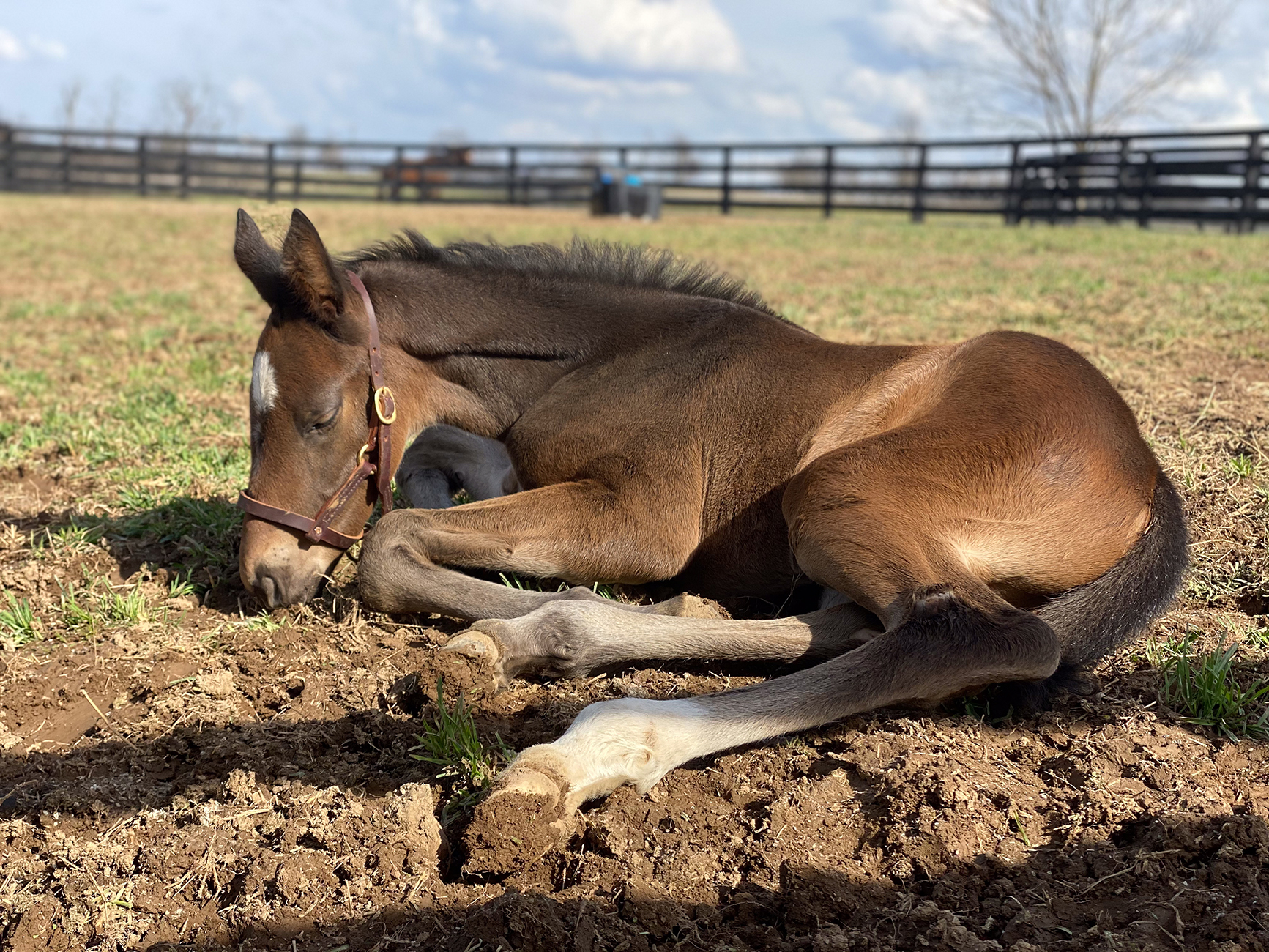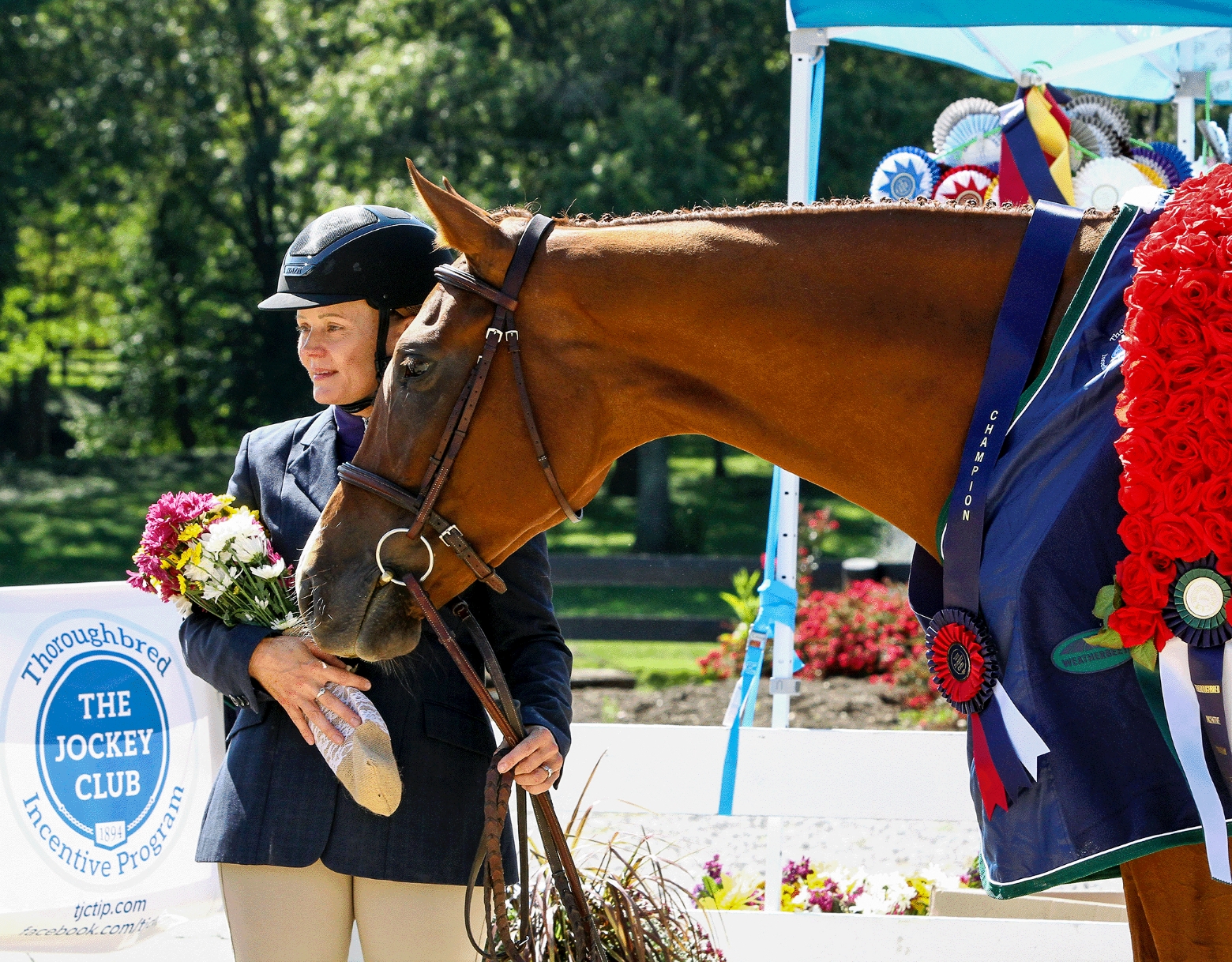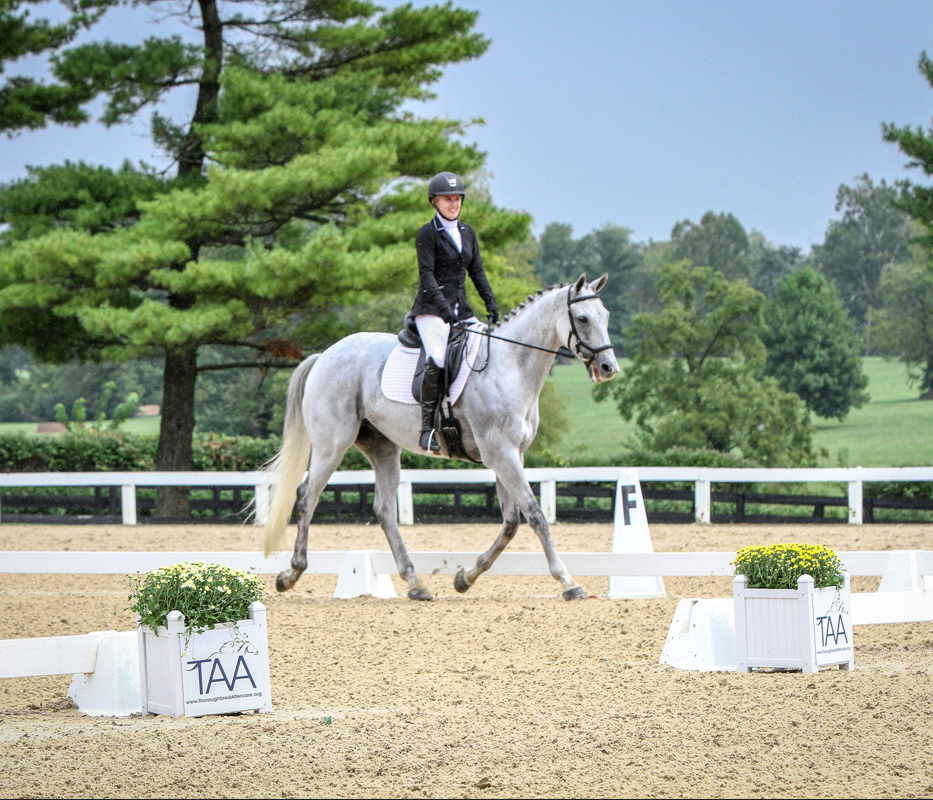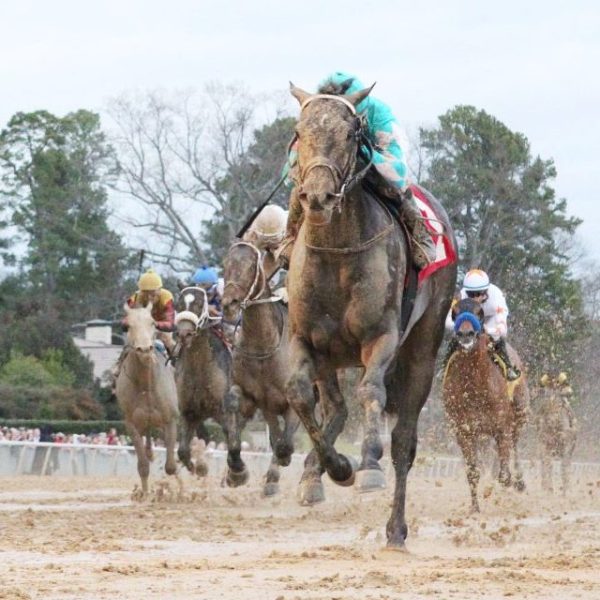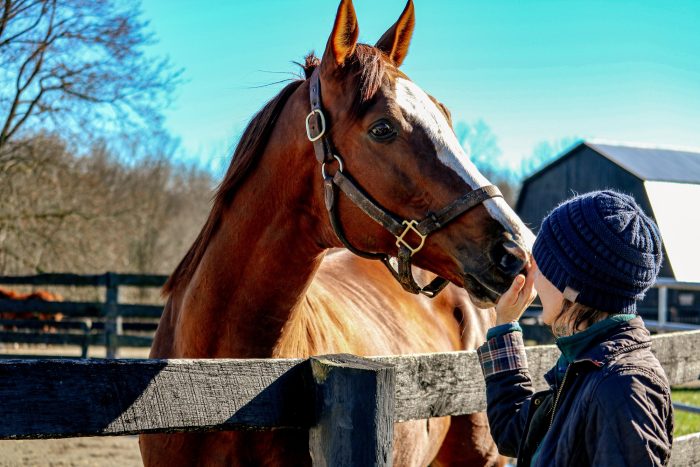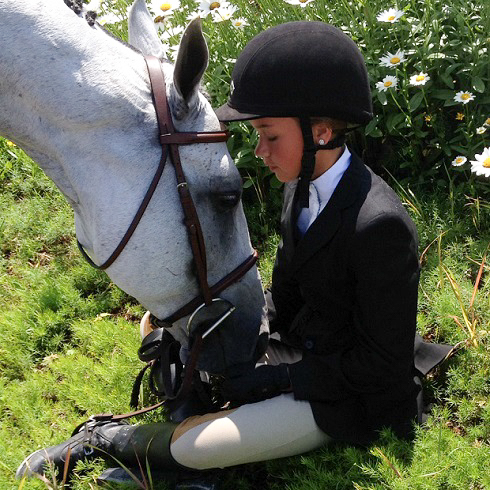The Jockey Club
All Posts & News Press Releases Success Stories Aftercare Editorials Retraining Tips Supporter Features Inspector Spotlights Humberger Toggle Menu Previous Post The Importance of Traceability in Thoroughbred Racing & Aftercare This article was originally featured in the July 2024 Issue of BloodHorse Magazine in the Second Acts series. This article is the original format and text. To read the BloodHorse article or to subscribe click HERE. The Importance of Traceability in Thoroughbred Racing & Aftercare By: Samantha Smith September 11, 2024 Aftercare Editorials Tags:BloodHorse Magazine, Equine Safety, Equine Welfare, Horse Inventory, The Jockey Club, Thoroughbred Aftercare, Thoroughbred Aftercare Alliance, Traceability Mom’s Reward pictured taking a nap. Tracking a horse’s information and whereabouts throughout its life, known as traceability, is indispensable in horse racing. It’s vital for equine welfare, industry integrity, and accountability. In North American Thoroughbred racing, traceability is essential from birth to post-racing but poses persistent challenges. Effective inventory control should be a priority, reducing uncertainty about Thoroughbreds’ whereabouts. Thoroughbred Aftercare Alliance mandates inventory reports from accredited organizations, although only after horses reach these facilities. Thoroughbred Aftercare Alliance consulted with various racing professionals, gaining insights into traceability challenges and perspectives across the industry. Jill’s Story: A Breeders’ Quest for Traceability and Accountability Jill Pritchard, a dedicated equestrian and breeder, emphasizes the importance of traceability in racing. Her firsthand experiences underscore the challenges breeders face in ensuring the welfare and whereabouts of their horses. Jill shares both positive and negative anecdotes, illustrating where challenges beyond her control persist and improvements can be made. Despite her best efforts, she couldn’t trace some foals after selling them as yearlings, reflecting broader industry challenges in ensuring Thoroughbred welfare and whereabouts. Mom’s Reward pictured as a foal. Photo Credit: Amy Lanigan. Mom’s Reward Mom’s Reward is a tragic example of a horse lost in the system. A 2021 filly by Preservationist out of Ventoux. After her sale, the filly never had a published workout, let alone raced. Despite Jill’s attempts to contact the trainer, she received no response. Eventually, Jill learned that Mom’s Reward was euthanized due to a breakdown in training, though this information remains unconfirmed. The lack of traceability and communication left Jill feeling helpless. Unable to confirm the horse’s fate or reach the trainer, she could do nothing to assist Mom’s Reward. Kicksandgiggles pictured at the sales. Kicksandgiggles Kicksandgiggles, trained by Jeff Hiles, stands out as a success story amid the challenges of traceability. Kicksandgiggles is a 2020 gelding by Bernardini out of Driving Rain. Thanks to the help of Buff Bradley, Jill was able to connect with the trainer when she sold him as a yearling and maintain communication with Jeff Hiles throughout the horse’s career. Jill was able to get the horse back when Jeff was ready to retire him, and ensured he transitioned into training for a second career. Today, Kicksandgiggles lives happily with his new owner in Minnesota, a testament to the importance of open communication and accountability in ensuring the welfare of Thoroughbreds beyond the racetrack. Bottle Rocket Bottle Rocket, a 2012 colt by Intense Focus out of Shoes to Match, was sold as a weanling for $5,500 and went on to win over $226,000. His first owner and trainer kept Jill updated on his progress, but after he was claimed and moved out West, communication became difficult. Eventually, Jill learned from a trainer that Bottle Rocket was retired to the owner’s farm after his last race at Del Mar. Over two years later, he resurfaced at a Quarter Horse meet in Los Alamitos. Despite her best efforts, including speaking with the track steward and reaching out on social media through the Posse Foundation and various Thoroughbred groups, Jill was unable to get any updates from his connections or determine his whereabouts after his last race in January 2020. Kicksandgiggles as a foal with his mother. Kicksandgiggles playing in the field. Kicksandgiggles as a foal. Jill with Mom’s Reward. Mom’s Reward taking a nap. The Registration Process The Jockey Club is the breed registry for North American Thoroughbreds, and it outlines the eligibility rules and requirements for a foal to become a registered Thoroughbred. Since 2017, the implant and reporting of a microchip has been a condition of registration, and in 2018 Digital Certificates of Foal Registration were introduced, replacing traditional paper documents. Both initiatives were aimed at improving identification tools for Thoroughbreds, but also to enhance means of traceability. While these measures have been a welcome development for the Thoroughbred industry, the responsibility of updating ownership still lies primarily upon individual stakeholders. Best practices would see ownership being updated to The Jockey Club each time a horse is transferred, but compliance isn’t guaranteed. Beyond Racing Once a Thoroughbred’s racing career ends, tracking its post-racing journey can be additionally challenging. While the breed registry does not mandate reporting a horse’s retirement, a process is available through The Jockey Club, called Transferred as Retired from Racing, that enables an owner to retire a Thoroughbred from racing without affecting its breeding privileges. If a Transferred as Retired from Racing Thoroughbred is entered at a North American racetrack, racing officials are electronically notified that the horse is retired. In addition, it is free to transfer ownership of a Thoroughbred using The Jockey Club Registry’s Interactive Registration at registry.jockeyclub.com. In addition, once a horse makes it to a Thoroughbred Aftercare Alliance-accredited facility, there are mandatory requirements in place for reporting and managing horse inventory. “Thoroughbred Aftercare Alliance mandates inventory reports from all accredited organizations four times annually,” said Suzie Oldham, Thoroughbred Aftercare Alliance, Inspections Administrator. “This meticulous approach ensures that horses at each of the organization’s facilities are registered Thoroughbreds creating a traceable record of horses passing through the program and offering peace of mind to previous owners who may be seeking their equine companions.” Conclusion From birth to retirement, every horse deserves a clear and accountable journey. With industry-wide initiatives and advancements in technology, the goal of comprehensive traceability is within reach. As The Jockey Club’s traceability initiative
Read More >All Posts & News Press Releases Success Stories Aftercare Editorials Supporter Features Inspector Spotlights Previous Post The Jockey Club’s Key Role in Industry Initiatives for Thoroughbred Aftercare The Jockey Club’s Key Role in Industry Initiatives for Thoroughbred Aftercare By: Samantha Smith March 22, 2024 Supporter Feature Tags:supporter, Supporter Feature, The Jockey Club, Thoroughbred Aftercare Alliance Supporter, TIP, TJC TIP The Jockey Club is the non-profit Thoroughbred breed registry for the United States, Canada, and Puerto Rico, with the primary responsibility of maintaining The American Stud Book. Its mission is being dedicated to the improvement of Thoroughbred breeding and racing. The Jockey Club also has several commercial businesses and partnerships whose profits are regularly invested back into the Thoroughbred industry. Each of these businesses touches a point in the life of a horse, from the breeding shed, to the sales ring, to the racetrack, to careers beyond. As a founding member and one of the three industry stakeholders that provided Thoroughbred Aftercare Alliance with initial seed funding and ongoing support, The Jockey Club recognizes aftercare as an integral industry initiative that requires sustainable backing. “The Jockey Club believes that the horses come first and that the industry has a commitment to its horses throughout their life cycles,” said James L. Gagliano, president and COO, The Jockey Club. “Supporting Thoroughbred Aftercare Alliance is in line with our mission and our other efforts toward Thoroughbred aftercare.” What makes Thoroughbred Aftercare Alliance stand out among other aftercare organizations is that it accredits the facilities it funds. Supporters of Thoroughbred Aftercare Alliance know that its facilities meet high standards each year and that the horses are receiving the best care possible under the best conditions. James L. Gagliano President and COO, The Jockey Club The Jockey Club demonstrates its support through various methods. Funds from nearly every registry-related transaction are allocated to Thoroughbred Aftercare Alliance, and The Jockey Club provides housing and administrative support for Thoroughbred Aftercare Alliance in its Lexington office, free of charge. “What makes Thoroughbred Aftercare Alliance stand out among other aftercare organizations is that it accredits the facilities it funds,” said Gagliano. “Supporters of Thoroughbred Aftercare Alliance know that its facilities meet high standards each year and that the horses are receiving the best care possible under the best conditions.” The Jockey Club Thoroughbred Incentive Program (T.I.P.) is one of many industry initiatives spearheaded by The Jockey Club to support aftercare. In addition to supporting Thoroughbred Aftercare Alliance, The Jockey Club has significant involvement in aftercare through numerous avenues. Within the Registry, there are a few ways aftercare is supported: The Jockey Club’s Checkoff Program The Jockey Club’s checkoff program enables owners and breeders to financially assist five charities by selecting one of the designated amounts or an amount of their choice on the Application for Foal Registration form or during the payment process on Interactive Registration. Thoroughbred Connect Thoroughbred Connect is a resource for horse owners who are looking to rehome a Thoroughbred when its racing or breeding career comes to an end. It is voluntary and is provided free of charge to Interactive Registration users through The Jockey Club Registry. The platform enables people to sign up to provide aftercare assistance for specific horses, while enabling the person assigned a horse’s digital certificate to see if anyone signed up to provide support for that horse. Sold as Retired from Racing Sold as Retired from Racing enables a horse to be listed with The Jockey Club as permanently retired from racing without affecting the horse’s use as a broodmare or stallion. The form can be filled out on paper, notarized, and sent to The Jockey Club or it can be completed digitally. The buyer and seller of the horse must sign the form, and current photos of the horse must be provided for identification purposes. In addition to the Registry, The Jockey Club has aftercare touchpoints through some of its industry initiatives. The Jockey Club Thoroughbred Incentive Program (T.I.P.) was created to encourage the retraining of Thoroughbreds into other disciplines upon completion of careers in racing or breeding. Launched in 2011, T.I.P. offers Thoroughbred awards at open horse shows and competitions, a championship horse show, year-end Performance Awards, a recreational riding program, a Thoroughbred of the Year Award, and a Young Rider of the Year Award. The Jockey Club is also involved with other aftercare initiatives, including the International Forum for the Aftercare of Racehorses and United Horse Coalition. “To ensure the future of our sport, we must ensure its horses have a future after racing,” said Gagliano. “Each of us, whether owners, breeders, trainers, jockeys, fans, or executives, must contribute to Thoroughbred aftercare if we want Thoroughbred racing to thrive.” To learn more about The Jockey Club and its supported aftercare initiatives you can visit their website here. THE JOCKEY CLUB’s AFTERCARE INITIATIVES Learn more about Thoroughbred Aftercare Alliance’s supporters: Industry Stakeholders Share This Article
Read More >The Jockey Club Thoroughbred Incentive Program (T.I.P.) will host two championship shows in 2022: The T.I.P. Championships & Eastern Dressage Championships will be held October 6 through 9 in Aiken, South Carolina, and the T.I.P. Western Championships & Central Dressage Championships will take place October 12 through 15 in Lexington, Kentucky, in conjunction with the Retired Racehorse Project’s Thoroughbred Makeover. Stable View Equestrian Center will host the South Carolina Championship show, which welcomes hunter, jumper, English pleasure, dressage, combined test and English in-hand competition. The Kentucky Horse Park will host dressage, Western dressage, barrel racing, Western pleasure, Western halter, ranch riding, and competitive trail competition. Both championship shows will feature in-hand classes, including classes designed to specifically celebrate horses that have started 50 or more times, have won more than $100,000 in earnings, and were adopted from Thoroughbred Aftercare Alliance-accredited organizations or Thoroughbred Charities of America grantees. Six special awards will be given at each show, recognizing the youngest, oldest, most recently raced, highest earning, highest sale price, and most raced Thoroughbred. The 2022 shows are poised to welcome nearly 350 Thoroughbreds competing in 38 divisions. Each division will be awarded $2,000 in prize money with awards through 10th place. “We are excited to expand a full T.I.P. championship horse show to two locations in 2022 after offering just a barrel racing division in Kentucky in 2021,” said Kristin Werner, senior counsel for The Jockey Club and administrator of T.I.P. “Splitting the disciplines between both facilities will allow us to better highlight the versatility of the Thoroughbred in a range of disciplines; it will also allow even more competitors to show off their mounts.” View the virtual program for the T.I.P. Championship at https://tjctip.com/resources/2022_TIP_Champs_Program.pdf. Created and announced in October 2011, T.I.P. recognizes and rewards the versatility of the Thoroughbred through sponsorship of Thoroughbred classes and high point awards at sanctioned horse shows, performance awards, and non-competition awards. In addition to the complete schedule of T.I.P.-sponsored shows, other information about the program is available on the T.I.P. website, tjctip.com. Those interested in T.I.P. can follow the program at facebook.com/tjctip. The Jockey Club, founded in 1894 and dedicated to the improvement of Thoroughbred breeding and racing, is the breed registry for North American Thoroughbreds. In fulfillment of its mission, The Jockey Club, directly or through subsidiaries, provides support and leadership on a wide range of important industry initiatives, and it serves the information and technology needs of owners, breeders, media, fans and farms. It founded America’s Best Racing (americasbestracing.net), the broad-based fan development initiative for Thoroughbred racing, and in partnership with the Thoroughbred Owners and Breeders Association, operates OwnerView (ownerview.com), the ownership resource. Additional information is available at jockeyclub.com. Cover Image: Suzie Oldham-Picou
Read More >T.I.P. Championships In 2022, The Jockey Club T.I.P. will offer championship divisions for Hunters, Jumpers, English Pleasure, Dressage, Combined Test, In-Hand (English and Western), Western Dressage, Western Pleasure, Ranch Riding, Barrel Racing and Competitive Trail. Each of the divisions at the Championships will offer prize money. T.I.P. Championships are open only to qualified and declared horses. For information on USDF Dressage Finals, please visit tjctip.com/About/USDF. 2022 Show Information 2022 T.I.P. Championships at Stable View & East Coast Dressage Championships October 6 – 9, 2022 Stable View, Aiken, SC Dressage, Hunters, Jumpers, Combined Test, English pleasure, English In-Hand Qualified Horse Declaration Deadline: August 31, 2022 Hardship Request Deadline: August 31, 2022 Prize List: tjctip.com/resources/2022_prize_list_aiken.pdf Entries: evententries.com/#ShowMTQ2MA==
Read More >The need to ensure responsible ownership at all stages of a racehorse’s life was a recurring theme at this week’s Thoroughbred Owner Conference, which was held July 25-26 in the 1863 Club at Saratoga Race Course. The event, which attracted more than 100 attendees, was presented by the New York Racing Association (NYRA) and hosted by The Jockey Club and Thoroughbred Owners and Breeders Association. The keynote address of the conference was delivered by Stacie Clark-Rogers, operations consultant for the Thoroughbred Aftercare Alliance (TAA). Clark-Rogers summarized the evolution of aftercare over the last 50 years and its increased prioritization among those involved in the Thoroughbred industry. She touched on the various organizations and initiatives formed by the industry to support aftercare, including the Thoroughbred Retirement Foundation, Thoroughbred Charities of America, Retired Racehorse Project, Thoroughbred Incentive Program, and TAA. She talked about the importance of the TAA and its role as racing’s accrediting and funding body for aftercare. Among the organizations accredited by the TAA are groups that offer equine-assisted therapy (EAT) by utilizing off-the-track Thoroughbreds, and Clark-Rogers advocated for EAT as an option for these horses. “These programs in my opinion are greatly undervalued, and we could be doing so much more to connect people with retired Thoroughbreds, and in return, promote the horse, the industry, and the sport of horse racing,” she said. “If we have learned anything over the last 20 years of aftercare initiatives, we all need to work together in all aspects of this industry, not just so the aftercare groups can succeed, but so the industry can be more accountable and thus succeed as a responsible, ethical sport.” Other topics of focus at the conference included buying at the sales, selecting a trainer, equine safety, partnerships, and international racing. The second day of the event featured a panel composed of a family of jockeys: Dylan Davis was joined by his sister Katie and her husband, Trevor McCarthy, with an appearance by Dylan and Katie’s father, former jockey Robbie Davis. The discussion was moderated by Eclipse Award-winning jockey Richard Migliore, who currently works as a racing analyst for NYRA. Tony Allevato, chief revenue officer for NYRA and president of NYRA Bets, opened the conference by describing efforts NYRA has made to improve the racing and ownership experience. For example, during NYRA’s racing coverage on Fox Sports, the production team makes it a priority to interview owners before and after each race. “It’s important for us as an operator to make the experience as good as possible,” he said. “If an owner thinks that there’s a chance that they can get on national TV, we think that adds to the experience.” The conference began with a reception at the National Museum of Racing and Hall of Fame, and attendees enjoyed the races at Saratoga on Wednesday. “After being postponed for two years due to COVID-19, we were delighted to finally bring the Thoroughbred Owner Conference to Saratoga for the first time,” said Gary Falter, project manager for OwnerView. “Competing at Saratoga is a dream for any Thoroughbred owner and a fitting location for this conference, where we provide existing, new, and prospective owners the opportunity to learn about all aspects of owning racehorses while facilitating networking with the industry’s most prominent names.” Tom Durkin served as the master of ceremonies. Participants on the panels included owners Tina Bond, H. James Bond Racing Stable and Song Hill Thoroughbreds; Michelle Borisenok, Old Tavern Farm; Peter Brant; Terry Finley, West Point Thoroughbreds; Tom Gallo, Dream Maker Racing; Len Green, D.J. Stable; Jack Knowlton, Sackatoga Stable; and others. A video replay of all panels at the conference will be available at ownerview.com within the next week. OwnerView is a joint effort spearheaded by The Jockey Club and the Thoroughbred Owners and Breeders Association to encourage ownership of Thoroughbreds and provide accurate information on aspects of ownership such as trainers, public racing syndicates, the process of purchasing and owning a Thoroughbred, racehorse retirement, and owner licensing. The need for a central resource to encourage Thoroughbred ownership was identified in the comprehensive economic study of the sport that was commissioned by The Jockey Club and conducted by McKinsey & Company in 2011. The OwnerView site was launched in May 2012. Additional information about OwnerView is available at ownerview.com or by contacting Gary Falter at gfalter@jockeyclub.com or 859-224-2803. Photo: Daniel Segal
Read More >If you own a Thoroughbred in training, you most likely have heard of the many aftercare options available to you and your racing community. With 82 Thoroughbred Aftercare Alliance (TAA)-accredited organizations across North America and many supporting triage programs at major racetracks, the transfer of a retiring Thoroughbred can be seamless. One concern in this process is ensuring a retired horse will not be entered in a race under new connections. Often a retired horse will be transferred from the track to a trainer or an organization, but the foal certificate is left active. This misstep is a liability for the racing connections, but more importantly, it can be a threat to the horse’s safety. There are protocols in place to prevent this from happening. All TAA-accredited organizations have an adoption contract, which states the horse is being sold as “Not for racing.” However, the process that officially ensures the horse’s Jockey Club certificate will be made inactive for racing must be filed through The Jockey Club’s Registry Office. The Jockey Club registrar Rick Bailey explained the “Sold as Retired From Racing” process, which notifies North American racetracks of the retired status for Thoroughbreds. “If an owner wishes to mark their certificates as ‘Retired From Racing,’ there’s a process to do that for Thoroughbreds that are registered with The Jockey Club,” Bailey said. “It involves returning the completed form, which includes the notarized signature of both parties, photographs so that we can verify the identity of the horse, and The Jockey Club Certificate of Foal Registration to our office so that it can be recorded and stamped accordingly.” All of the necessary information and the “Sold as Retired From Racing” form are readily available online at www.registry.jockeyclub.com/registry. “Some tracks are more aware of the retired process than others—certainly the aftercare organizations are much more aware and a good number of the ‘Retired From Racing’ horses that we receive are from aftercare facilities,” Bailey said. A seasoned veteran of the “Sold as Retired From Racing” process, TAA-accredited Second Stride executive director Kim Smith shares her perspective as an aftercare facility taking in recently retired Thoroughbreds who still need their TJC papers to be stamped as inactive. “Second Stride transitioned 143 Thoroughbred sport horses to new homes last year for many types of post-racing uses and jobs,” Smith said. “We received foal certificates from the donating connections either digitally or in hard copy for approximately 40% of the horses.” TAA-accredited organizations such as Second Stride sometimes face a challenge in tracking down the Certificate of Foal Registration. “Often the papers are at a racetrack already closed for the meet. They’re left behind or transferred to the next track,” Smith said. “We often hear they were left in a van driver’s glove box. “So far this year we have had four out of 20 horses arrive with foal papers and a notarized form ready for executing to The Jockey Club ‘Sold as Retired From Racing’ database,” Smith said. “This year we started sending The Jockey Club ‘Sold as Retired From Racing’ form link to all our donors; we ask it be executed upon entry.” With the introduction of digital certificates, beginning with the 2018 foal crop, thankfully this issue is on the decline as Thoroughbreds with paper certificates age out of racing. Aside from the ‘Sold as Retired From Racing’ form, TAA-accredited organizations take additional precautions to provide a safety net for horses adopted from their organization. “We provide strict ‘No Race’ language in our adoption contracts,” Smith said. “Second Stride places our horses in the Equibase Virtual Stable Mail to be notified if a horse has published works or races. We then can proactively try and find out what is going on for any alerts. Usually it is a name similar to that of another horse currently working. This past Thanksgiving morning we had 2018 Kentucky Derby (Presented by Woodford Reserve [G1]) runner My Boy Jack show up with a published work. He was transitioned through our program and his adopter actually allows us to use him as an ambassador horse on tours, so we knew right where he was. We were able to reassure the prior connections that he was well and grazing on the farm.” Many TAA-accredited organizations also are careful to safeguard their adopted horses from going to slaughter by having clear language in their adoption contracts. Furthermore, the adopter agrees to include the same “No race or slaughter” language in any future sale contracts. “The adopted horse is placed with a lifetime ‘Not for race or slaughter use’ clause,” Smith said. “The adopter agrees that neither they, nor any future person or owner, shall race or slaughter the adopted horse, sell the adopted horse for race or slaughter use, or cause the horse to become available for purchase at an auction that could place the horse at risk of slaughter or race use.” While it is trickier to reclaim an OTTB at-risk of slaughter, Kim Smith’s team has a solid plan in place if an adopted horse shows up on the track. “The ‘bat’ phone starts ringing,” she said. “We would immediately notify the stewards of the related tracks, the track ownership, the track vets, and The Jockey Club. We can readily provide our paperwork and vet work to establish the situation and request the horse be put on the steward’s/track’s ‘No race’ list. We can also request that our attorney submit a ‘cease and desist’ letter to the person(s) in question, as well as to the other related parties. Our contract language also has provisions for return of the horse to Second Stride, and legal work can be started for that as well.” While TAA-accredited organizations do their best to provide a safety net for our industry’s athletes with or without the “Sold as Retired From Racing” form, the nonprofits end up spending considerable time, money, and resources that could otherwise go toward caring for more horses. “We find horsemen and owners are making a mental
Read More >This year the Thoroughbred Aftercare Alliance celebrates 10 years of service since being established by the industry—an anniversary that offers racing an opportunity to make actionable goals for continued support of Thoroughbreds. Here is a look at where TAA has been in those years and where it might be going, with help from racing and aftercare industry veterans: Jeff Bloom, TAA president and managing director of Bloom Racing; Richard Schosberg, director and aftercare chair of the New York Thoroughbred Horsemen’s Association, president of TAKE THE LEAD, and TAA board member; Kristin Werner, senior counsel for The Jockey Club and administrator of the Thoroughbred Incentive Program; Jen Roytz, former executive director of the Retired Racehorse Project; Anna Ford, Thoroughbred program director for TAA-accredited New Vocations Racehorse Adoption Program; Lisa Molloy, program director of TAA-accredited ReRun; Laurie Lane, cofounder and president of TAA-accredited Second Call Thoroughbred Adoption & Placement; and Kim Smith, founder of TAA-accredited Second Stride. Q: Why is there a need for industry oversight of aftercare? Werner: The conversations about aftercare really started for me around 2009 or 2010. There was some retraining, retirement, and adoption going on and organizations like Thoroughbred Retirement Foundation, New Vocations, and Thoroughbred Charities of America were doing good work. But, the overall aftercare picture looked a bit piecemeal with gaps in services and areas of the country. And, it was not supported in any large part by the racing industry. As social media continued its rise in popularity, more and more cases of “rescue organizations” needing to be rescued began to appear. The general public became more aware of the fate of Thoroughbreds once their racing careers were complete. It was apparent that a multi-faceted solution was needed, which included accreditation of organizations providing aftercare, a funding source from industry constituents for those organizations to do their work, and incentive programs for Thoroughbreds in a second career. In the years that followed, this was accomplished through the formation of the Thoroughbred Incentive Program, Thoroughbred Aftercare Alliance, Retired Racehorse Project, and numerous other regional and track-based organizations focused on supporting organizations providing aftercare. Molloy: Prior to the formation of the Thoroughbred Aftercare Alliance, there was a time when there were so many rescues and programs operating without any guidance, provisions, or checks and balances. This created issues for those wanting to donate their horses and those wanting to donate money. Finding a way to responsibly retire a horse and ensure an empathetic and compassionate retirement with viable second career options really was a difficult path to navigate for an owner. The processes that are in place, especially using Thoroughbred Aftercare Alliance-accredited organizations working in partnership with racetrack programs like TAKE THE LEAD, provide transparency and prevent horses from falling through the cracks. Q: In the past decade what have you learned about the versatility of the Thoroughbred? Bloom: Over the last 10 years we have seen numerous examples and heartfelt stories of re-trained, re-homed, and re-purposed off-the-track racehorses. From assisting with therapeutic care for mentally and physically challenged children and adults, to full-blown sporting events such as polo, dressage, and eventing, to backyard trail riding, participating in television and movies and everything in-between, the Thoroughbred racehorse has proven to be incredibly kind, intelligent, versatile, and durable for use following their racing careers. Werner: I am fortunate to see on a daily basis how versatile the Thoroughbred is through my work with the Thoroughbred Incentive Program. We have Thoroughbreds participating in and excelling in hunter/jumpers, eventing, dressage, English and Western pleasure, barrel racing, ranch work, endurance, working equitation, therapeutic riding, equine-assisted therapy, mounted police, polo, polocrosse, competitive trail, recreational riding, and even skijoring. I am sure there are more that I am missing. Lane: It was the best kept secret. For those of us who worked with Thoroughbreds, we knew the versatility and the many incredible talents and tasks our Thoroughbreds could achieve just given the chance. Q: Do you think there has been a new interest in the Thoroughbred as a sport horse? Roytz: A thousand times yes. One of the most meaningful statistics that comes out of the data we collect from our Thoroughbred Makeover competitors each year is the ratio of first-time competitors versus repeat participants. Each year a significant portion of the competitors at the Thoroughbred Makeover are competing at the event, and often taking on the retraining of a Thoroughbred, for the first time. RRP’s mission is a bit different from most other aftercare organizations in that it focuses on expanding the market and increasing demand for Thoroughbreds in equestrian sports rather than doing hands-on re-training and re-homing. I strongly believe it takes both approaches to aftercare to be successful. The Jockey Club’s Thoroughbred Incentive Program and the TAKE2 program, both of which offer Thoroughbred-specific shows, horse show classes, and prizes throughout the country, as well as TIP’s recreational riding prizes and incentives, are other great examples of ways to incentivize equestrians to actively choose Thoroughbreds over other breeds for equestrian sports. Q: What do you think the factors in this have been that have helped a new interest in the use of the Thoroughbred? Roytz: Programs like the Retired Racehorse Project, The Jockey Club Thoroughbred Incentive Program, TAKE2 show series, and others that incentivize equestrians to compete on Thoroughbreds is a major driver in garnering new interest for Thoroughbreds in the equestrian world. I think adjusting our messaging as an industry will continue to help to appeal to equestrians. By positioning Thoroughbreds not as “retired racehorses” (which naturally insinuates a conclusion to their use/usefulness) but as “Thoroughbred sport horses” or “sport horse prospects” will make them more appealing to a non-racing equestrian audience as it focuses on these horses’ potential in new sports, the sports they are being marketed for, and that they will likely spend a more significant portion of their life doing. Q: What have been some of the most important developments of Thoroughbred Aftercare in the last 10 years? Ford: In the last 10 years
Read More >Stable Currency, a 10-year-old resident of TAA-accredited Outside In, earned the 2019 T.I.P. Young Rider of the Year Award with his mount Alexa McVoy.
Read More >





